Sketching in Space
Monoocular Tracking for hybrid interaction
Sketching in Space was an interdisciplinary project, which started in 2007 as part of Johann Habakuk Israel's doctoral thesis at the Fraunhofer IPK Berlin, division Virtual Product Creation, and the graduate school prometei of the TU Berlin. His thesis focussed on usability aspects, the empirical investigation and possible applications of immersive sketching in product design.
Interface design
Low-Fidelity Prototypes were created during our early conceptual work to understand the tools spatial use in the CAVE environment. The images below show the first versions of the tools.
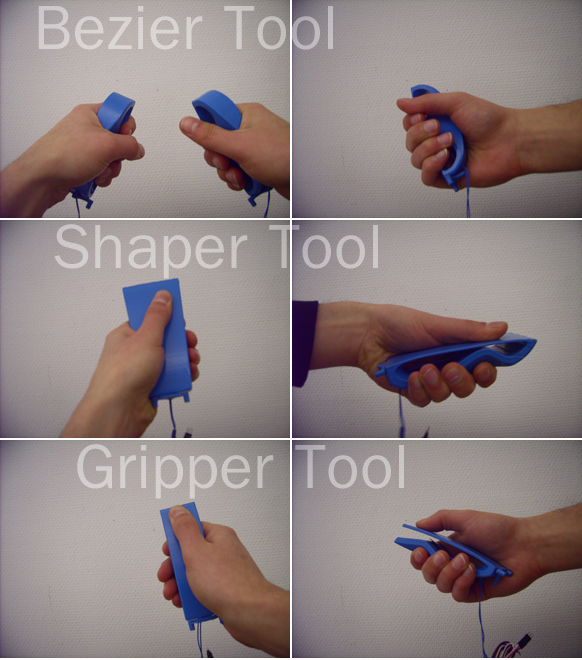
The sketching tools consisted of a pen for 3D sketching, a bezier curve tool for extruding a surface, a shaper for shaving off material like a sculpturer, and a gripper to take elements of a sketch and position them somewhere else.

The pictures above show the final version of the sketching toole: Pen, Bezier Tool, and Gripper.
Motivation
The main motivation behind the feasibility analysis of the monoocular tracking was the distortet magnetic field of the tracking system in place.
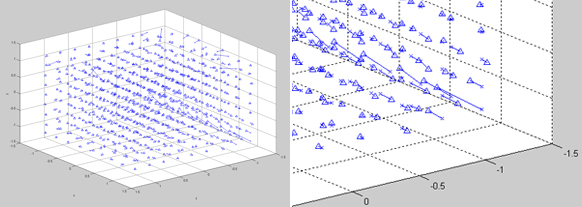
With a vision based system precision would increase, but it would also mean to cut holes into the projection walls that would break the illusion of a 3D image floating in front of ones eyes. Typical vision based tracking systems at that time used a stereoskopic approach to determine 6DOF of a target. Thus, increasing the number of holes which would be needed to cut into the CAVEs walls. Monoocular tracking would reduce the 'damage' to the interaction.
Speed analysis of a sketching hand
To understand the requirements for an optical system, the maximum possible speed of a sketching hand was determined. In a standing position hand movement trajectories in x,y, and z direction were executed with maximum possible accelleration. The movements were recorded with a high-speed camera.
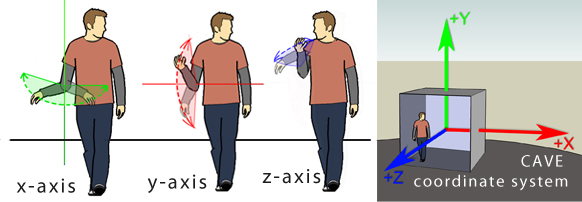
The table below summarizes speeds of x,y,z-translation and rotation. All movements were classified as active and passive ways of execution. A movement is defined as active if the full force of the muscle is applied to accelerate the pen. The passive movement is a result of the arm bouncing back as the full extension of the joints was reached.

Average Speed
As the measures above only indicate maximum possible speeds, which only will be reached relatively rarely, further analysis was aimed at average sketching speeds. The graph below shows a 3D-sketche's velocity seperated in x,y and z direction. Also here movements into z-direction are much slower.
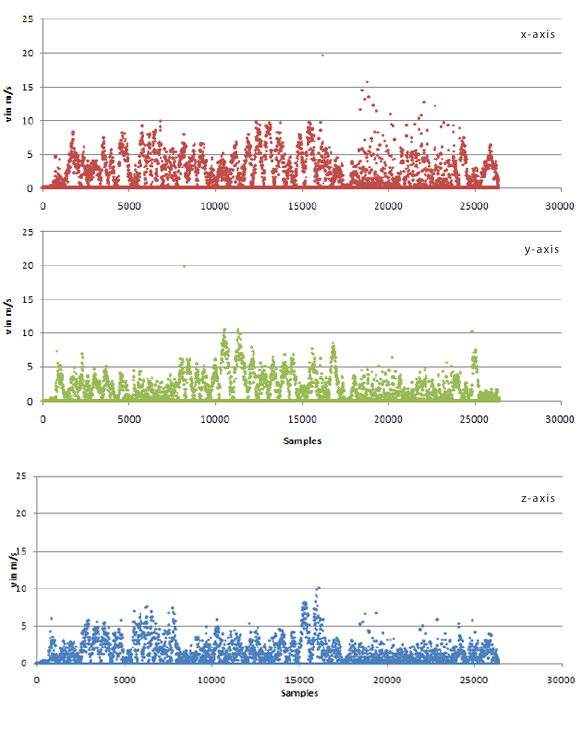
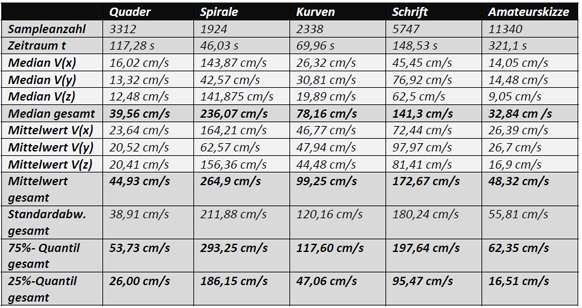
Speed trajectories

Monoocular Tracking
For the test system fire-wire cameras with a configurable imaging chip were used.
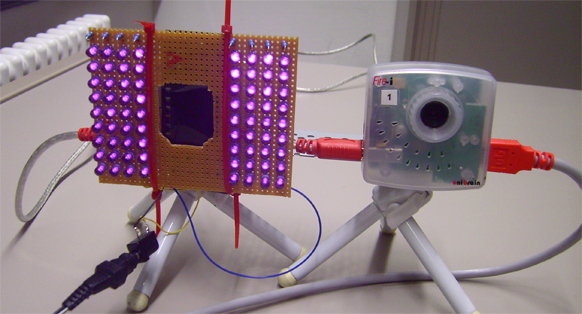
To find pixels from one camera image in the other camera image, epipolar line algorithms were also tested as shown in the picture below. There are still multiple cameras needed, because of occlusion caused by the body of the user.
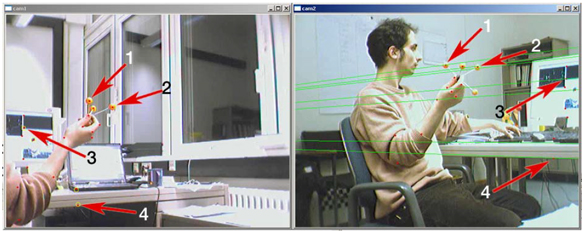
However, the main algorithms doing the work needed were the POSIT and SoftPOSIT. Images below show the test implementation.
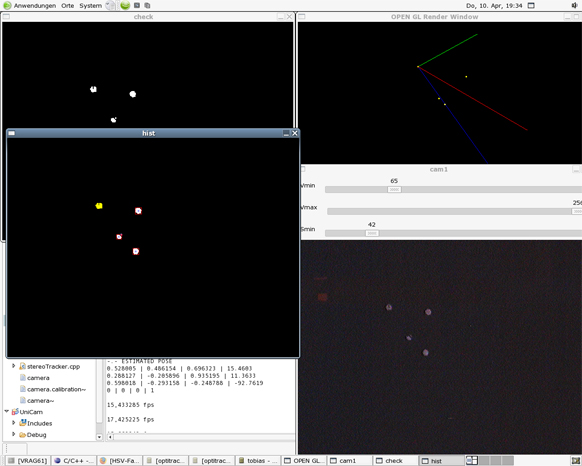
Conclusion
t.b.a.
References:
J. H. Israel, Chr. Zöllner, M. Mateescu, R. Korkot, G. Bittersmann, P. T. Fischer, J. Neumann, and R. Stark. 2008. Investigating user requirements and usability of immersive three-dimensional sketching for early conceptual design: results from expert discussions and user studies. In Proceedings of the Fifth Eurographics conference on Sketch-Based Interfaces and Modeling (SBM'08), Christine Alvarado and Marie-Paule Cani (Eds.). Eurographics Association, Aire-la-Ville, Switzerland, Switzerland, 127-134.
Völlinger, U., Israel, J. H., Belaifa, O., Fischer, P. T., Korkot, R., Kulf, L., Mateesucu, M., Meyer, A., Müller, A., Perkunder, H., Piatza, S., Schäfer, J., Wiese, E. und Zöllner, C. (2011) Sketching in Space. In: Proc. Scheinbar Sein. Faktisches und Virtuelles, Universitätssammlungen KUNST+TECHNIK, ALTANAGalerie, TU Dresden, 46-47.
Israel, J. H. (2010) Hybride Interaktionstechniken des immersiven Skizzierens in frühen Phasen der Produktentwicklung. Dissertation, Berlin: Technische Universität Berlin.
Israel, J. H., Wiese, E., Mateescu, M. & Stark, R. (2009) Investigating three-dimensional sketching for early conceptual design — Results from expert discussions and user studies. Computers & Graphics 33(4), 462-473.
Stark, R., Israel, J. H., and Wöhler, T. (2010). Towards hybrid modelling environments — Merging desktop-CAD and virtual reality-technologiess. CIRP Annals – Manufacturing Technology 2010(59), 179-182.
Wiese, E., Israel, J. H., Meyer, A., and Bongartz, S. (2010). Investigating the Learnability of Immersive Free-Hand Sketching. In: Proc. ACM SIGGRAPH/Eurographics Symposium on Sketch-Based Interfaces and Modeling SBIM’10, Annecy, France, ACM SIGGRAPH and the Eurographics Association. 135-142.
Wiese, E., Israel, J. H., Zöllner, C., Pohlmeyer, A. E. & Stark, R. (2009) The Potential of Immersive 3D-Sketching Environments for Design Problem-Solving. In: Proc. 13th International Conference on Human-Computer Interaction HCI 2009. San Diego, CA, USA
Lead Research:
Prof. Dr.-Ing. Johann Habakuk Israel
Design and Concept:
Christian Zöllner
Sebastian Piatza
Alexander Müller
System Engineering:
Patrick Tobias Fischer
Achim Meyer
Helen Perkunder
Rasim Korkot
Lennart Kulf
Johannes Schäfer
Researcher:
Dr. Eva Wiese
Oliver Belaifa
Dr.-Ing. Ulrike Völlinger
Magdalena Mateescu

